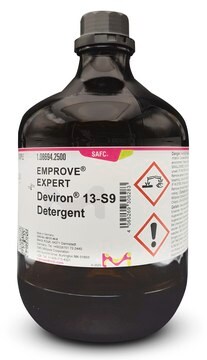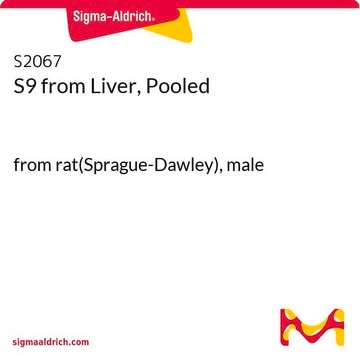A1420
Ames′ Medium
With L-glutamine, without sodium bicarbonate, powder, suitable for cell culture
Sign Into View Organizational & Contract Pricing
All Photos(1)
About This Item
UNSPSC Code:
41161501
NACRES:
NA.75
Recommended Products
Quality Level
form
powder
technique(s)
cell culture | mammalian: suitable
components
glucose: 1.081 g/L (Dextro)
NaHCO3: no
L-glutamine: 0.073 g/L
shipped in
ambient
storage temp.
2-8°C
General description
Ames′ Medium has been formulated to support retinal tissue in relatively short-term culture. It is suitable for maintaining central nervous system tissue in vitro.
Application
Ames′ Medium has been used to maintain rat/mice/macaque monkey eye for the isolation of retina.
Quantity
Formulated to contain 8.8 grams of powder per liter of medium.
Reconstitution
Supplement with 1.9 g/L sodium bicarbonate.
Storage Class Code
11 - Combustible Solids
WGK
WGK 2
Flash Point(F)
Not applicable
Flash Point(C)
Not applicable
Certificates of Analysis (COA)
Search for Certificates of Analysis (COA) by entering the products Lot/Batch Number. Lot and Batch Numbers can be found on a product’s label following the words ‘Lot’ or ‘Batch’.
Already Own This Product?
Find documentation for the products that you have recently purchased in the Document Library.
Customers Also Viewed
Frans Vinberg et al.
Vision research, 101, 108-117 (2014-06-25)
The Function of the retina and effects of drugs on it can be assessed by recording transretinal voltage across isolated retina that is perfused with physiological medium. However, building ex vivo ERG apparatus requires substantial amount of time, resources and
Qiuju Jiang et al.
IEEE transactions on neural systems and rehabilitation engineering : a publication of the IEEE Engineering in Medicine and Biology Society, 26(5), 969-976 (2018-05-13)
Significant progress has been made recently in treating neurological blindness using implantable visual prostheses. However, implantable medical devices are highly invasive and subject to many safety, efficacy, and cost issues. The discovery that ultrasound (US) may be useful as a
Antoine Chaffiol et al.
Molecular therapy : the journal of the American Society of Gene Therapy, 25(11), 2546-2560 (2017-08-16)
The majority of inherited retinal degenerations converge on the phenotype of photoreceptor cell death. Second- and third-order neurons are spared in these diseases, making it possible to restore retinal light responses using optogenetics. Viral expression of channelrhodopsin in the third-order
John M Nagarah et al.
Frontiers in neuroscience, 9, 384-384 (2015-11-06)
Multielectrode arrays (MEAs) allow for acquisition of multisite electrophysiological activity with submillisecond temporal resolution from neural preparations. The signal to noise ratio from such arrays has recently been improved by substrate perforations that allow negative pressure to be applied to
B Ameline et al.
Gene therapy, 24(11), 735-741 (2017-09-08)
Several preclinical studies have investigated the potential of algal channelrhodopsin and human melanopsin as optogenetic tools for vision restoration. In the present study, we assessed the potentially deleterious effects of long-term expression of these optogenes on the diseased retina in
Protocols
Powdered media and salt mixtures are extremely hygroscopic and should be protected from atmospheric moisture.
Our team of scientists has experience in all areas of research including Life Science, Material Science, Chemical Synthesis, Chromatography, Analytical and many others.
Contact Technical Service











